-
Posts
11,151 -
Joined
Content Type
Profiles
Forums
Store
Help Articles
Posts posted by slkinsey
-
-
Absolutely. Demeyere only has a thin external magnetic layer. With Mauviel Induc'Inox the entire inner thermal layer is magnetic.
-
Exactly. Crack a few raw eggs on top just before the pizza goes into oven. The eggs cook through before they dry out (mostly, imo, by "frying" from the heat coming up through the crust). It helps to have very fresh eggs for this, as they will not spread as much as older eggs. This is, needless to say, only possible to do well with a very thin crust and a very hot rock.
It's a much more elegant presentation in true Neapolitan-style single-serving format. That way you have one egg in the center of the pizza.
-
What are the proportions [of AP flour to cake flour you use]? 50/50?
I don't measure exactly, but I'd say I use around 25% - 33% cake flour.
Sam, those pix are astonishing. The first shot of the topping larder was breathtaking, and they got better from there.When you answer Jason's question, can you also give brands? Do you have a preferred AP and cake flour?
No preferred brands, really. The cake flour was Swans Down, because that's what seems to be available around here. I often use Hecker's, which I think is a good quality AP flour. As chance would have it, I used Hodgson Mill AP flour this time. I prefer either Hecker's, Hodgson Mill or King Arthur.
How do you stop the top of the egg drying out and toughening when you cook the egg on the pizza in the oven? Lots of cheeae on top?The cheese is under the eggs. Primarily, I guess I avoid drying by simply not baking it for very long -- around 5 minutes. And I like to use a fair amount of tomato on the pizze with eggs, so perhaps the steam mitigates any drying.
-
I ran out of 00 flour, so I used regular AP flour mixed with cake flour (highly refined, low protein flour) -- which I find is a good approximation of 00 for pizza.
-
Mauviel Induc'Inox.
-
This article by Tony Cecchini in today's NY Times magazine had some interesting information about maraschino cherries:
In the late 1800's, marasca cherries macerated in maraschino liqueur became a delicacy among affluent Europeans and, from there, made the leap to fine hotels and restaurants in America. The prized sweet of its time, it was flourished by competitive barmen as the ultimate garnish. The alcoholic content of the cherries, however, made them an easy target for the temperance movement, thereby opening the door for good old American reinvention.Turn-of-the-century tinkerers found that pickling the Royal Ann cherry in an alum-and-salt brine, then resweetening and dyeing it and adding artificial almond flavoring, yielded a far cheaper version that quieted the concerns of both the parsimonious and the teetotaling. By the 1920's these imitations had displaced the platonic version in name as well as market.
So, it appears that the real think is simply sour cherries marinated in maraschino liqueur. The author used frozen Cascadian Farms whole organic sweet cherries (which apparently actually contains sour cherries) and marinated them for several days in maraschino with delicious results. Anyone with access to a farmer's market could probably do even better with fresh sour cherries.
-
Wait, so Alberto, "real" pizza flour is low protein flour? I assumed bread flour (higher protein content) would be more appropriate. Anyone care to discuss the differences or, better yet, do an experiment using two different flours but otherwise similar techniques?
I've discussed this a number of times on eG. Yes, real Italian pizza flour is lower in protein than American bread flour. It's also perhaps a bit lower than American AP flour as well. In addition, "00" flour is more highly refined. That said, not all "00" flour is the same (the "00" refers to the level of refinement, not the protein level). "00" flour for pizza is higher in protein than "00" flour for pasta. Still not as high as American AP flour, though. A lower protein, more refined American flour might work well, such as the biscuit flours from the Southeast.
I personally find that a lower protein flour gives a crust that is more to my liking. But I make what are fundamentally Italian-style pizze. American style pizze have a lot more stuff on top of them, and it is likely the case that a stronger dough is required in order to support those toppings.
-
Last night I had a bunch of friends over for one of my pizza-making marathons. These are fundamentally Italian style pizze, but in a larger size so everyone can have a piece of each one. I don't have any pictures of the dough or anything like that, but here are the finished products:
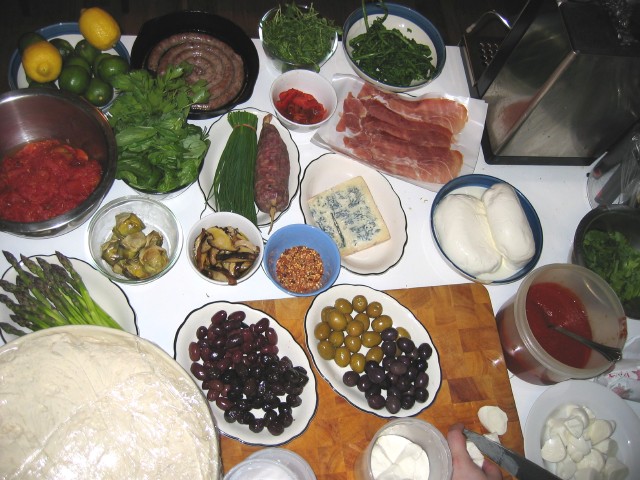
Here are all the ingredients. I use a fairly wet dough that fermented for around 12 hours (I usually go 24 hours, but realized last night that I was out of flour). Fat Guy and I traveled up to Arthur Avenue for some of their amazing best-of-class fresh mozzarella -- as good as any fior di latte mozzarella I've had in Italy.

We started with a margarita.
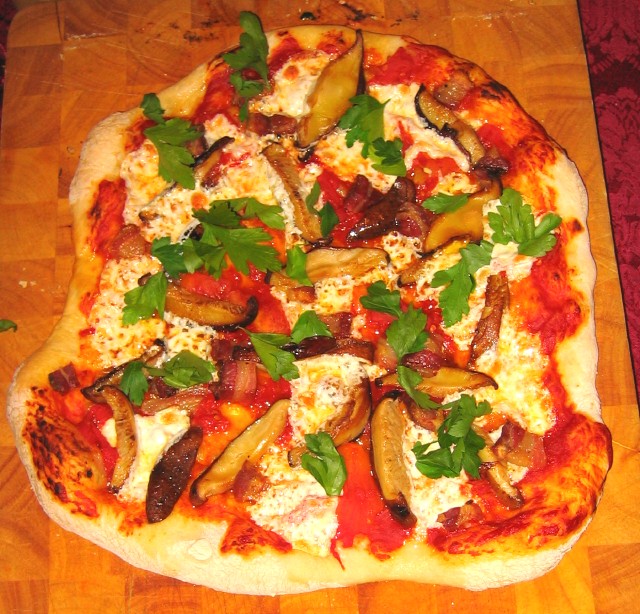
Shitake mushrooms and cubes of pancetta.
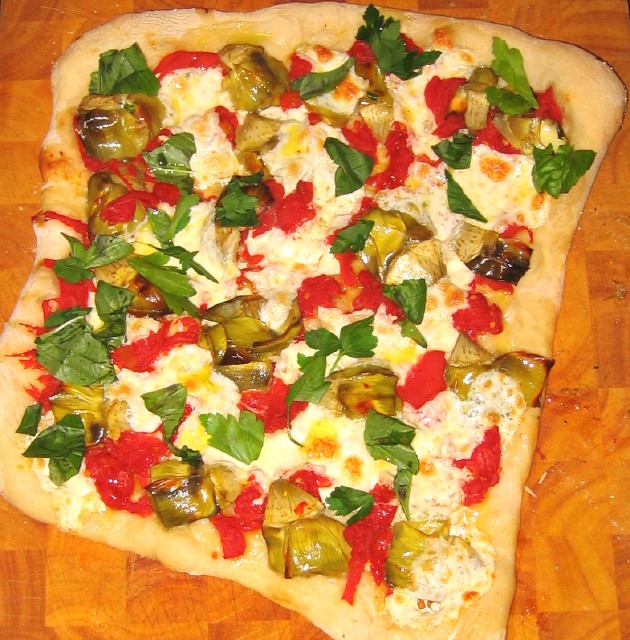
Fresh artichoke and filetti di pomodoro.
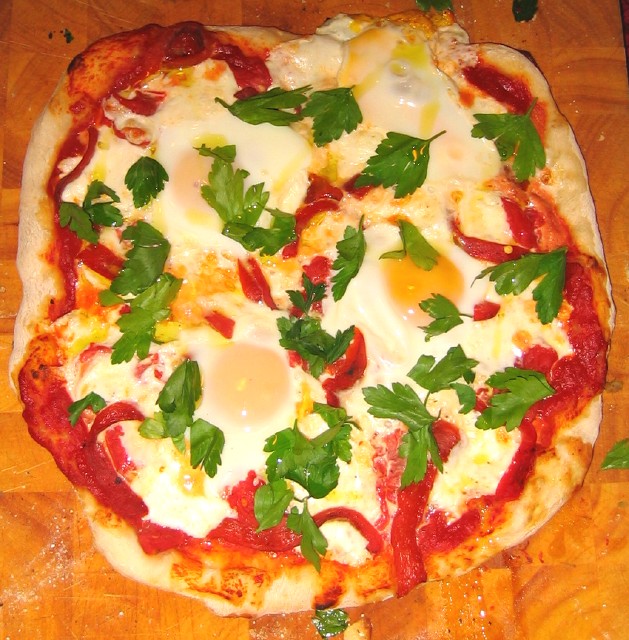
Red peppers with eggs "fried" right on the crust.

Here is a picture of an egg slice.
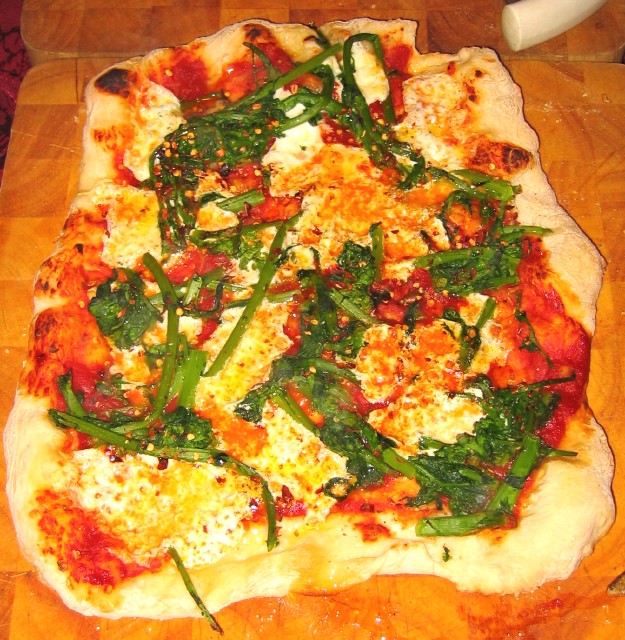
Spicy broccoli rabe.
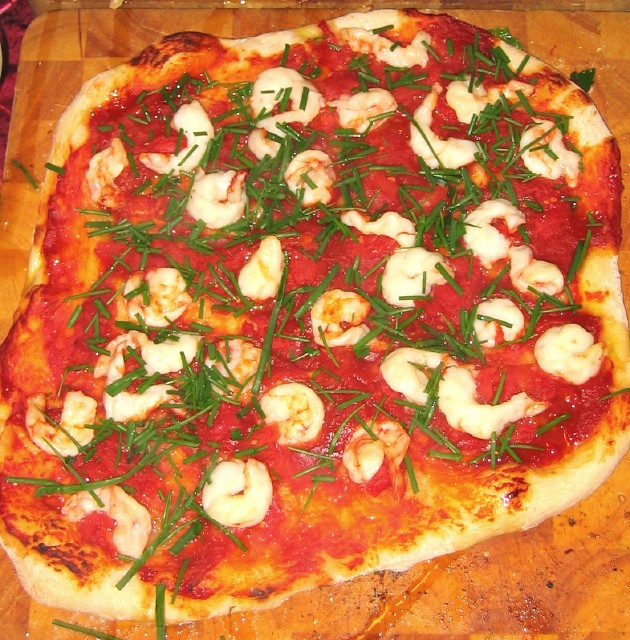
Shrimp and chives.
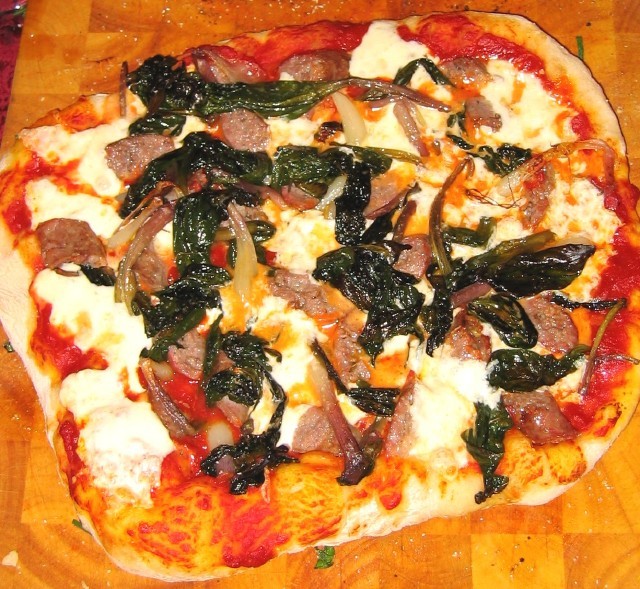
Sausage and ramps.
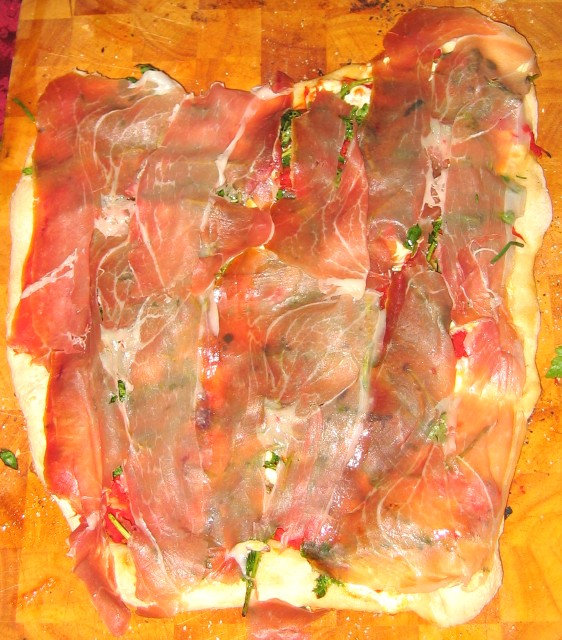
A "pizza nonna" -- a tomato/mozzarella pizza topped with a dressed salad (upland cress, in this instance) with prosciutto draped over the top.
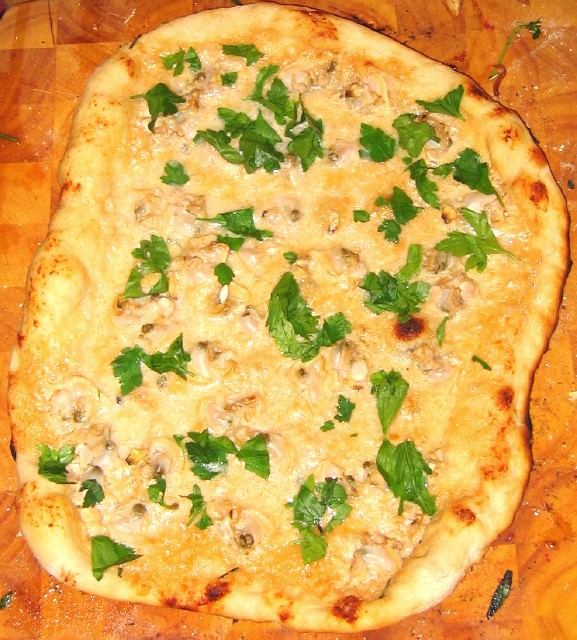
Littleneck clams baked right on he crust.
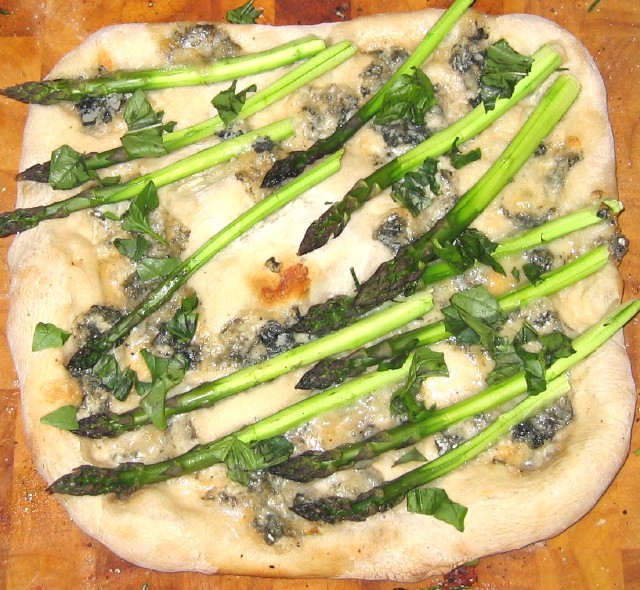
Gorgonzola picante and asparagus. You can see that the stones in the oven were beginning to lose heat by this point.
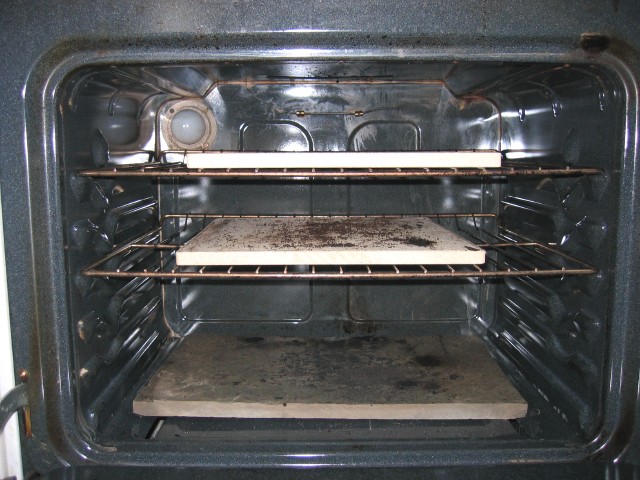
Here's my oven setup. As you can see, it's a crappy residential stove -- actually pretty good for a Manhattan apartment. There are two levels of stones, with the stone on the bottom being a slab of slate from docsconz's back yard. I only baked on the two lower stones, sometimes transferring a pizza from the bottom stone to the middle stone if we weren't quite ready for the next pizza. Especially in the beginning, the slate stone was throwing up some serious oven spring and baking the pizze in around 5 minutes. I estimate that the slate weighs around ten times more than the conventional baking stones.
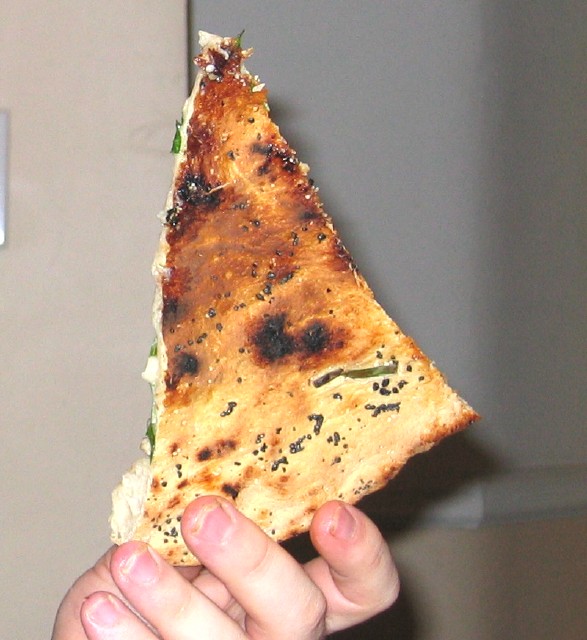
Here is a view of the bottom of the crust towards the end of the run. Still getting good thermal performance from the slate, although the baking time increased to around ten minutes by the last pizza.
-
I fear this guy has never had a proper martini:
2 parts gin (Hendrick's, perhaps)
1 - 2 parts dry vermouth (I prefer made in the U.S.A. Vya)
a dash of orange bitters
lemon twist
shaken, not stirred
THERE we go. Thank you, thank you.
That is a classic martini at least by the history I've read. . .
Well, to pick a nit, I love the formula (2:1 or 1:1 with a dash of orange bitters), but I always stir my martini as I don't like it to be cloudy. Besides, I am given to understand that, if you use cracked ice, the drink actually comes out colder if you stir rather than shake.
-
Actually, when using bitters on the finished drink, one is usually adding a drop or two rather than a dash or two. A classic example is the Pisco Sour, where pisco is shaken up with sugar, lemon juice and raw egg white, strained in to a cocktail glass and then garnished with several drops of Angostura bitters. Looks cool and produces an entirely different effect than adding it to the shaker would.
-
. . . for every drink you find using a dash of something strong, you find one using a dash of something relatively mild, usually just for color adjustment, like curacao or grenadine.
The effect of a dash of something like curacao, maraschino or grenadine depends greatly on the other ingredients and how the dash is deployed (dashes on the top of a finished drink have a different effect, for example, being more noticable in the nose). And, of course, on the hand of the person who is doing the dashing. In a drink formula like the Savoy's Aviation, we have 2 ounces of gin, 1 ounce of lemon juice and two (presumably fairly heavy compared to a dash of, say, Angostura bitters) dashes of maraschino. I wouldn't say that the maraschino in this drink is being used "just for color adjustment" (not least because maraschino is colorless). But, of course, a single dash of maraschino is unlikely to make a difference in the taste of, say, a Negroni.
Some liquors are, of course, used in dash quantities for coloration purposes (the odious blue curacao comes to mind), but I'm not sure it's fair to suggest that this is typical of all or even most such uses. On the contrary, I would suggest that a dash or two of kummel or curacao or maraschino or strega (etc.) could absolutely cause a different and unique impression depending on the context. Whether the addition of a dash of X or two dashes of Y makes for a new drink is a subject that's up for debate. It is absolutely the case that, back in the old days, there were differently named drinks that had the exact same ingredients for all intents and purposes. Sometimes the name of the drink might change simply based on the brand of liquor. But, then again, it's also the case that some drinks with radically different formulations shared the same name.
Fair enough, I will admit that juniper tends to play better with orange peel than orange juice. I didn't bring up the subject trying to get people up in arms, I'd honestly thought juniper was a challenging flavor to mix with, and was looking for advice. I hadn't realized how dear a spirit gin was in the hearts of this board's members. If I am in fact mistaken, and gin is indeed the most easily mixed of spirits, and the reason why me and my friends enjoy gin and lillet more than, say, gin and cream is simply because of personal preference and not because gin's characteristics make it more suitable for mixing with one by itself than the other, then so be it, I apologize. Perhaps this is in fact a matter of me not being quite sophisticated enough to enjoy gin's "subtle flavors" in more than a limited number of circumstances. But I appreciate the feedback.No need for any apology. I think it's just the case that some people find gin more challenging than others, and some people only like the flavor in certain contexts. Hey, some people don't like foie gras. I happen to hate everything in the squash family, but a lot of people love squash. And don't even get me started on the discussions I've had with people here about okra.

PS. For a gin and cream drink, try a Ramos Fizz (shake it hard for at least a minute).
-
Wasn't meaning to imply that gin was simply a vodka substitute, merely that the reason that it was so popular had to do with the fact that it could be used in the same manner as vodka (to dilute existing flavors without adding many strong flavors of its own) with moderate success. Just scrolling down the list I found 1,2,3,4,5.
Interesting. To my eye, those drinks do not appear to be using gin as a diluting agent. They are gin cocktails (1, 3 and 5) and cocktails where gin is being used as a flavoring agent (2). The most unusual cocktail is #4, the Bunny Hug cocktail, with equal parts gin, pastis and bourbon. A case could be made that part of the function of the gin is to dilute the flavor of the pastis. But, at the same time, it still brings the unique gin flavor to the drink. In fact, I have to disagree with the assertion that gin can "dilute existing flavors without adding many strong flavors of its own." One of the reasons you and others may have difficulty with gin is precisely because it most often does contribute strong and distinctive flavors when it is used in a cocktail. Is Tanqueray or Gordon's less assertive than, say, Old Overholt rye or Bacardi silver rum? I wouldn't say so.
-
I love gin, and find vodka extremely uninteresting. It takes something like Audrey's Smoking Martini (vodka flavored with laphroaig and such) to make a vodka drink at all appealing to me.
That's more or less my feeling as well. Vodka doesn't bring any flavor to the game, so I don't like to use it except in certain drinks where one can take advantage of its usefulness as a dilutant. Audrey's Dreamy Dorini Smoking Martini is a good example of this, as is Paul Harrington's "Drink Without a Name," which dilutes 1/4 ounce of Cointreau and 1/8 ounce of Green Chartreuse with 1.5 ounces of vodka. In both drinks the vodka is used to "spread out" otherwise intensely flavored indredients (Laphroaig 10 and Green Chartreuse, respectively), and in so doing to expose flavors that might otherwise have been obscured either by combination with other strong flavors or the inherrently concentrated flavors of the products themselves. Most of the time, though, vodka only brings alcohol to the game. To my mind, if I am drinking something that tastes like orange juice mixed with lime juice and cranberry juice, I feel no need to add any alcohol. In that case, you're only making a "cocktail" for the effect of the alcohol -- and that's not the reason I drink cocktails.
-
Do we have any reliable evidence that Mitchell's is closed? Or is it all rumor at this point?
-
So the question remains: is it really necessary to pre-heat for so long? I could understand it if the stone was two inches thick, but my quarry stones (and most of the pizza stones I had previously considered buying) are not quite 1/2 an inch. Does pre-heating for an hour make any difference than pre-heading for 30 minutes? How about 15 minutes? 5 minutes?
If you preheat for a long time, it means that everything in your stove -- not just the air inside the oven -- will come up to temperature. This is important in terms of radiant heat, and its important in terms of temperature recovery when you open and close the door of the oven.
Also, if you have a gas oven and the stones are on the floor of the oven, the burner is more or less firing directly into the stone. With careful manipulation of the oven, or simply turning it to "broil," you can easily get the stones over 550F. If you're making thin crust pizza, this is a good thing.
-
Gin does an admirable job being a vodka substitute if you can cancel out the juniper flavors.
Hmm. I guess we'll just have to chalk this one up to a radical difference in taste, then. If I had to give up one liquor and never use it in cocktails again, I would choose vodka without hesitation. I daresay most cocktail enthusiasts would say the same.
Gin is a remarkably complex liquor. Although juniper is the key note, it varies in prominence from producer to producer. And, while certain cocktail recipes and certain cocktail ingredients allow the juniper quality to shine through more than others, I don't agree that any successful cocktail "cancels out the juniper flavors" -- or indeed any of the flavor components of gin. It is often said that a truly successful cocktail has a flavor that isn't entirely identifiable as belonging to any of the constiuents of the drink. Dave makes a similar point upthread in saying that "a proper gin Martini . . . tastes neither of gin nor of vermouth, but of Martini." Think of it as adding that tiny grinding of nutmeg to a ragu Bolognese. The end result doesn't taste of nutmeg, but a ragu Bolognese made with nutmeg does taste different from one made without. Gin can do the same thing.
So, while some gin cocktails may not feature up-front juniper flavors as a key note, this does not mean that the juniper (and other flavors of the gin) aren't making a difference in the overall impression of the cocktail. As I said earlier with respect to the Pegu Club cocktail, it is quite easy to prove this point by tasting two examples of the drink side-by-side, one with gin as the base liquor and one with vodka. Try it. See if you don't think that they taste different. If they do taste different, then this means that the flavor of the gin has not been "canceled out" -- even if you can't definitively say "I taste juniper." I absolutely prefer the version with gin, and I think most cocktail enthusiasts would be in the same camp. But if you prefer the version with vodka, there's nothing wrong with that. It just means that you don't like gin all that much. except in certain limited contexts -- which, like it or not, seems to be what you've been saying. I go in the other direction. It's hard for me to think of a vodka cocktail that I wouldn't rather have made with gin.
-
But take things like the Pegu club down there; really the only reason why it appears to work to me is because the strength of the bitters overwhelm the natural flavor of the gin, and the lime juice complements what's left and helps it marry with the orange flavors. But I'm not sure if the juniper actually adds anything desirable to the game.
As Dave implied above, a drink doesn't necessarily have to smack of juniper in order for the gin to make an impact. Try it for yourself: make a Pegu Club with gin and make the same drink with vodka. The difference in flavor will be inescapable. Now, you may prefer the vodka version. All this tells me is that you don't care for gin all that much.
Juniper and orange don't seem to quite see eye to eye with eachother.I guess it's in the eye of the beholder (tongue of the taster?). My family has been making goose braised in orange juice and gin longer than I've been alive. To my taste, gin and orange go together like... well, gin and orange. I think a more perfect match is hard to find. There are about a zillion classic cocktails that include gin and either tciple sec or orange curacao. If I'm not mistaken, orange peel is a fairly standard botanical used in gin formulae.
In all the gin and orange-something based cocktails I've had, the only ones that have been any good have been ones that had peacemaker ingredients to help smooth out the conflicting flavors. Really this seems to go for most non sour fruit flavor combinations i've tried. It also doesn't seem to do so hot with nutty flavors like sherry or amaretto or oaky flavors like the ones you get from bourbon, brandy or rum, although it does seem to play well with chocolate for some reason.Again, I suppose this is a matter of taste. Gin is certainly a natural for sour fruit, but I've made or consumed any number of cocktails where gin is married with apricot, pear, cherry, all manner of berries, cassis, etc. In addition, I've had successful cocktails with gin and sherry, gin and nut liqueur, etc.
I mean, it just seems to me like there are few cocktails out there that require gin that another spirit couldn't do a better job at, simply because juniper is such a particular flavor. Try a Suffering Bastard using gin, and then try making it substituting bourbon instead. Try making a Chelsea Hotel with gin, then try switching it out for brandy and making a Sidecar instead. Make a Gin & It, then try substituting brandy for a Metropolitan or whiskey for a Manhattan instead. Make a Red Snapper with gin, then try switching it out for vodka and make a Bloody Mary instead. Generally there is a marked improvement.I don't see what you're saying here, except that you don't care for juniper. That's fine, of course. But that makes it hard for to recommend anything. cocktailDB, a database of cocktails from the golden age, lists 1381 gin cocktails. This compares to 531 aged brandy recipes, 595 bourbon and rye recipes, 497 rum recipes and 59 tequilla recipes. This, to my mind, speaks loudly about the mixability of gin.
-
Sounds good, Janet!
But... isn't Damrak an "international style Dutch gin" rather than a London dry gin (which is to say, more of an updated genever)?
-
From what I have been able to gather, they are similar. The Magnum Pro has a more "consumer friendly" handle.
-
Strait gauge doesn't make much sense for a saute pan unless it is heavy copper -- and even then it's mostly because the straight gauge pans have thicker copper than you can get with a disk-bottom design. I'd take this Sitram Magnum Pro saute pan over an All-Clad Stainless saute pan any day.
-
I really hate the rivets.
Yes, I hate them too, but a little brush with bon ami or barkeeper's friend and they're clean again.
It's a lot easier if you use oven cleaner.
-
For those who would like to explore the possibilities of Gin, I can think of no better flight of cocktails than the five Audrey prepared at the Discus event. Make these, and you'll know what gin can do as a mixer.
Corpse Reviver #2
An old-school classic
0.75 oz : Gin
0.75 oz : Cointreau
0.75 oz : Lillet Blanc
0.75 oz : Fresh lemon juice
2 drops : Absinthe, absinthe substitute or pastis
Shake with cracked ice and strain into a chilled cocktail glass.
Earl Grey MarTEAni
An Audrey Saunders original
1.5 oz : Earl Grey tea–infused gin*
1.0 oz : Simple syrup (1:1)
0.75 oz : Fresh lemon juice
1 : Raw egg white
(Infuse 1 tbsp of Earl Grey tea into 8 oz of gin for 2 hours, then filter off tea leaves.)
Shake hard with cracked ice to emulsify the egg white, then strain into a chilled cocktail glass and garnish with a lemon twist. Half-sugar the rim of the glass, if you like.
Gin-Gin Mule
An Audrey Saunders original
1.5 oz : Gin
0.75 oz : Lime juice
1.0 oz : Simple syrup (1:1)
2.0 oz : Ginger beer*
8 to 10 mint leaves
(Good with store-bought ginger beer but best with homemade: steep 1 pound of chopped ginger together with 1/4 cup of light brown sugar and the juice of two limes in one gallon of hot water for one hour, then strain off and cool.)
Muddle the lime juice, simple syrup, and mint leaves together. Add gin and shake well with ice. Strain into a highball glass filled with ice, top with ginger beer and garnish with a sprig of mint.
Jasmine
A Paul Harrington original
1.5 oz : Gin
1.0 oz : Cointreau
0.75 oz : Campari
0.5 oz : Fresh lemon juice
Shake with cracked ice and strain into a chilled cocktail glass.
Pegu Club
An old-school classic, for which there are many ratios you can use -- here's one formulation
2 oz : Gin
0.75 oz : Orange curacao
0.75 oz : Fresh lime juice
1 dash: Angostura bitters
1 dash : Orange bitters
Shake with cracked ice and strain into a chilled cocktail glass.
-
Gin is definitely the favored spirit for most "new old school" mixologists, I'd say. It's a white spirit that brings a lot of flavor to the table.
Personally, I think gin is a very easy mixer. At a recent gin tasting sponsored by DISCUS, Audrey Saunders mixed up 5 great gin cocktails, both new and old, that showed gin's versatility. They were: a Corpse Reviver #2 (gin, Lillet Blanc, Cointreau, lemon juice and a drop of absinthe), an Earl Grey MarTEAni (Earl Grey-infused gin, lemon juice, simple syrup and egg white), a Pegu Club (gin, orange curacao, lime juice, orange bitters and Angostura bitters), a Gin-Gin Mule (gin, lime juice, mint, simple syrup and home made ginger beer) and a Jasmine (gin, Cointreau, Campari and lemon juice). These drinks span a very wide variety of flavor profiles -- from sweet to sour to herbal to spicy -- and the gin worked brilliantly in each one.
For me, there is practically no drink that isn't good if you substitute gin for the standard base liquor. Gin muddled with mint and lime over ice with a splash of fizz water ("gin mojito")? Delicious. Gin with Cointreau, lime juice and splash of cranberry ("gin cosmopolitan")? Delicious. Gin, simple syrup and lightly bruised mint over finely crushed ice with a big mint garnish (gin julep)? Delicious. Gin with sweet vermouth and a dash of bitters ("gin manhattan")? Delicious. The list goes on. In fact, many of hypothetical "gin substitution drinks" are real gin drinks.
Needless to say, it's easier to fit gin into a cocktail if you like gin. But I'd rather use gin than vodka in just about any cocktail there is. Gin, at least, brings flavor to the game instead of just alcohol.
Gin doesn't play well with other spirits like bourbon or brandy or rum.While I'd say this is generally true, I'm not sure it's universally true. There are some good drinks, for example, with gin and rum. That said, by and large it is not advisable to mix with two or more base spirits. It makes for a muddled presentation of flavors.
For instance, gin & lillet works together perfectly; gin and orange juice not so well. Vodka and orange juice works much better; but vodka & lillet really isn't as refreshing.This is where we part ways. I think gin and orange juice (an Orange Blossom) is infinitely superior to vodka and orange juice (a Screwdriver). In fact, the Orange Blossom was one of my drinks of preference in my early (i.e., underage) drinking years. A Screwdriver doesn't taste like anything but alcoholic orange juice.
It may be the case that you haven't acquired a fondness for gin. Gin does have a tendcy to "dry out" drinks with its botanicals. I regard that as a positive thing, but many people nowadays do have a preference for sweet drinks. Many people nowadays also don't particularly enjoy the taste of alcohol, which is one reason there are so many "sweet flavored liqueur and 3 difference juices mixed with vodka" drinks out there. With gin, it's always clear that you are drinking booze, because nothing else tastes like gin.
It might help to understand your relationshiup with gin if you gave a few more examples of gin drinks you find difficult to like.
-
Perhaps I was not clear. Hamilton's chapter was about the Vesper as served as Pravda, but the passage I quoted was about Bond's drinking habits in general.
In the material I quoted, I think it's fairly easy to see that Hamilton is talking about the Bond movies, not the books. He's also talking about Bond's drinking preferences in the movies after the advent of the Vesper, and not implying that the Vesper was a product of the Smirnoff relationship. This seems fairly evident from his writing: ". . . the Vesper was a gin drink. The now familiar Bond martini . . . is the love child of an early deal with Smirnoff vodka when the Bond movies became popular." The emphasis is mine, but I think the distinction is clear between the Vesper and the vodka martinis that followed. In addition, since he says that the Smirnoff relationship happened "when the Bond movies became popular," it seems clear that this would not include Casino Royale.
If we look at the Vesper, it's fundamentally a gin drink. This supports Hamilton's assertion that Bond was "originally a gin drinker " when taking Martini-like drinks. After the Bond movies became popular, and the 007 series struck a deal with Smirnoff, the movie Bond tended to drink a lot of vodka martinis "shaken and not stirred." This is supported by the guy you linked to, who says:
The relationship between Smirnoff and James Bond began with Dr. No in 1962 and continued intermittently through The World Is Not Enough. In 2002, after being outbid by Finlandia for partnering rights to Die Another Day, Smirnoff announced it was pursuing a younger, more "social" demographic, thereby ending its forty-year relationship with the 007 series.In Hamilton's defense, he continues in the article with the following:
Despite Bond's famed finickiness about what and how he drinks, he hasn't been true to himself, at least in the movies. He drinks mint juleps in Goldfinger and rum Collinses in Thunderball. . . Only Felix Leiter, the CIA agent who is Bond's best friend in the series until he gets taken out of service by a shark in Live and Let Die remains faithful to the Bond martini.



Pizza: Cook-Off 8
in Cooking
Posted
Nice looking 'za, Behemoth.
Patrick and others, one comment regarding prosciutto. You want to put the prosciutto on the pizza after it comes out of the oven, not before. This is the way I've always seen it done in Italy.
Anyway... if you're like me, you usually have some leftover ingredients the day after making pizza. A little leftover dough, a little leftover mozzarella, a little leftover broccoli rabe, a little leftover tomato, a little leftover sausage... what to do? Why, make a calzone, of course!